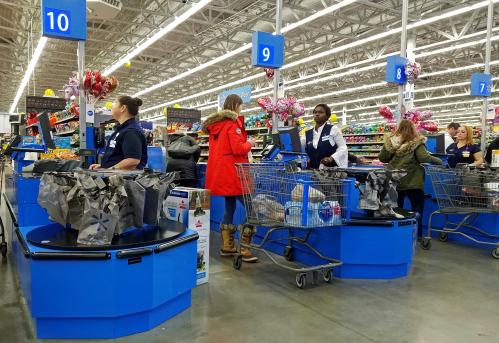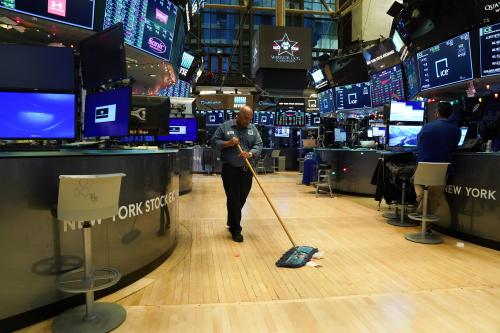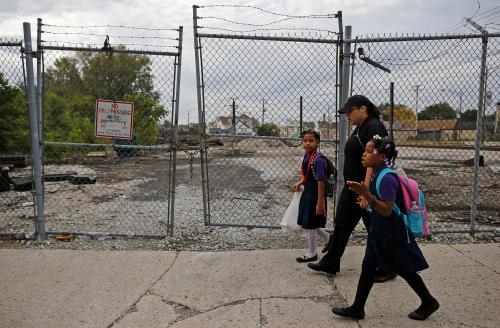In Tuesday’s State of the Union address, President Trump triumphantly declared that America is in the midst of a “blue-collar boom.” He described the “roaring” economy as the “best it’s ever been,” citing rising wages, low unemployment, and a soaring stock market.
But what do actual workers think? When I interviewed low-wage workers across the country last summer, what we heard was not a boom, but for many, a bust.
Over the past year, I led a human-centered research initiative with colleagues at New America to better understand how workers in some of the most common occupations across the country feel about their jobs, how those jobs are changing, and what their hopes are for the future. Our team traveled to Indianapolis, the Bay Area, the Washington, D.C. region, and Buffalo, N.Y. We interviewed dozens of low-income and blue-collar workers: cashiers, fast food workers, stock clerks, receptionists, retail workers, gas station staff, baristas, bookkeepers, and more. Several workers held more than one job, and many put in long, grueling days that started as early as 3 a.m.
In those interviews, four themes emerged that contradict Trump’s narrative.
First, low unemployment numbers are hiding widespread economic precarity. As my colleagues Martha Ross and Nicole Bateman pointed out, 44% of jobs in the U.S. pay so little that workers can barely afford to live. The stories we heard corroborate these statistics.
“The pay is not as high as I thought it would be,” a 23-year-old gas station manager told us. “I tell my husband, ‘I’m working my butt off there and I have to live check to check.’”
Many of the workers we spoke to expressed anxiety about their lack of a financial cushion to weather emergencies. “I don’t have the greatest car in the world,” one 25-year-old grocery worker said. “It is old and it’s probably going to break down on me soon, which would suck because I need it for work. I keep trying to save and I can’t. I’m constantly worried about it.”
Low-wage workers in expensive regions such as the Bay Area described going to great lengths to stay afloat, from living in groups in tight quarters to commuting long distances to working multiple jobs. The lesson? Employment only matters if workers can access quality jobs.
Second, rising wages mean little if workers can’t get enough hours or qualify for benefits. Many grocery and retail workers voiced frustration that their employers were raising hourly pay but making it harder for workers to get enough hours to pay their bills and—importantly—to qualify for health benefits. “In 18 years, I never got a full-time position, never,” one cashier lamented. “I can’t survive with 24 hours [a week].” A grocery manager said that so few of her colleagues get full-time hours, doing so is like winning the lottery: “[That’s] why you’re constantly seeing, ‘We’re hiring!’ But you can’t give me 40 hours.”
This struggle for hours is even more urgent because without enough, workers are often denied benefits such as health insurance. A manager at a large retail chain told us that his employer was increasing hourly pay for entry-level positions, but also cutting workers’ hours to save money on benefits: “The compensation is now a little bit better for team members, but if you lose your benefits and that is your goal, then I think you’ve lost a little.”
Third, despite the rosy headlines, workers described feeling uncertain and uneasy about their future. They described dramatic technological changes in their workplaces, with the introduction of self-ordering kiosks, self-checkouts, mobile ordering, grocery and food delivery, and curbside pickup lanes. “Things are changing every day,” said one 18-year-old retail cashier.
“Everything is about the bottom line and bonuses,” a 53-year-old grocery manager said. “When you have shareholders and people who want to get paid, they aren’t interested in people like myself, who made this company.”
Nearly every low-wage worker we interviewed expressed pessimism about the long-term future of human labor in their stores. “Robots, we know [they’re] coming,” a 44-year-old fast food worker said. “I don’t know how exactly, but it will change [things]. The people know it will change.” In Indianapolis, the mall’s remaining retail workers eyed shuttered storefronts as they described sharp increases in online sales. Headlines earlier this week of Macy’s plans to close 125 stores and lay off 2,000 employees are just the latest example of an industry in upheaval.
These changes are personal to Amber Stephens, a 29-year-old grocery worker and single mother who participated in the study. When she spoke at our report’s launch event in November, Amber was poised to be one of over 1,000 employees who would lose their jobs as Shoppers Food & Pharmacy closes 26 stores in Maryland and Virginia. She described the uncertainty she was feeling: “It is very scary, especially because I came into this job right of high school. So, first job—first real job. The thought of changing to a new job, maybe getting money but losing that health care and having to wait on that again—it is scary.”
Finally, workers with longer tenures denied Trump’s claim that the economy is the “best it’s ever been.” Employers once demonstrated “family values,” they told us—investing in employees and offering benefits, activities, and upward mobility to middle-class opportunities. But now workers believe their bosses focus on shareholders and profits above all else. “Everything is about the bottom line and bonuses,” a 53-year-old grocery manager said. “When you have shareholders and people who want to get paid, they aren’t interested in people like myself, who made this company.”
The wide gap between Trump’s State of the Union address and the reality of workers’ lives is illustrated by far more than compensation and employment figures. The working class today faces historic inequality in both power and prosperity. A more equitable economy that truly delivers for working people requires a rebalancing of that power, and policy changes to address the structural forces that exclude workers from shared prosperity: the long-term erosion of union representation, the fissuring of the workplace, financialization, monopsony power, an insufficient safety net and talent system, and the impact of globalization and technology.
Instead of simply declaring a “boom,” we should listen to what workers have to say about the state of their economy and give them a voice in what their future will hold.







Commentary
Trump’s State of the Union declared we’re in a “blue-collar boom.” Workers don’t agree.
February 6, 2020